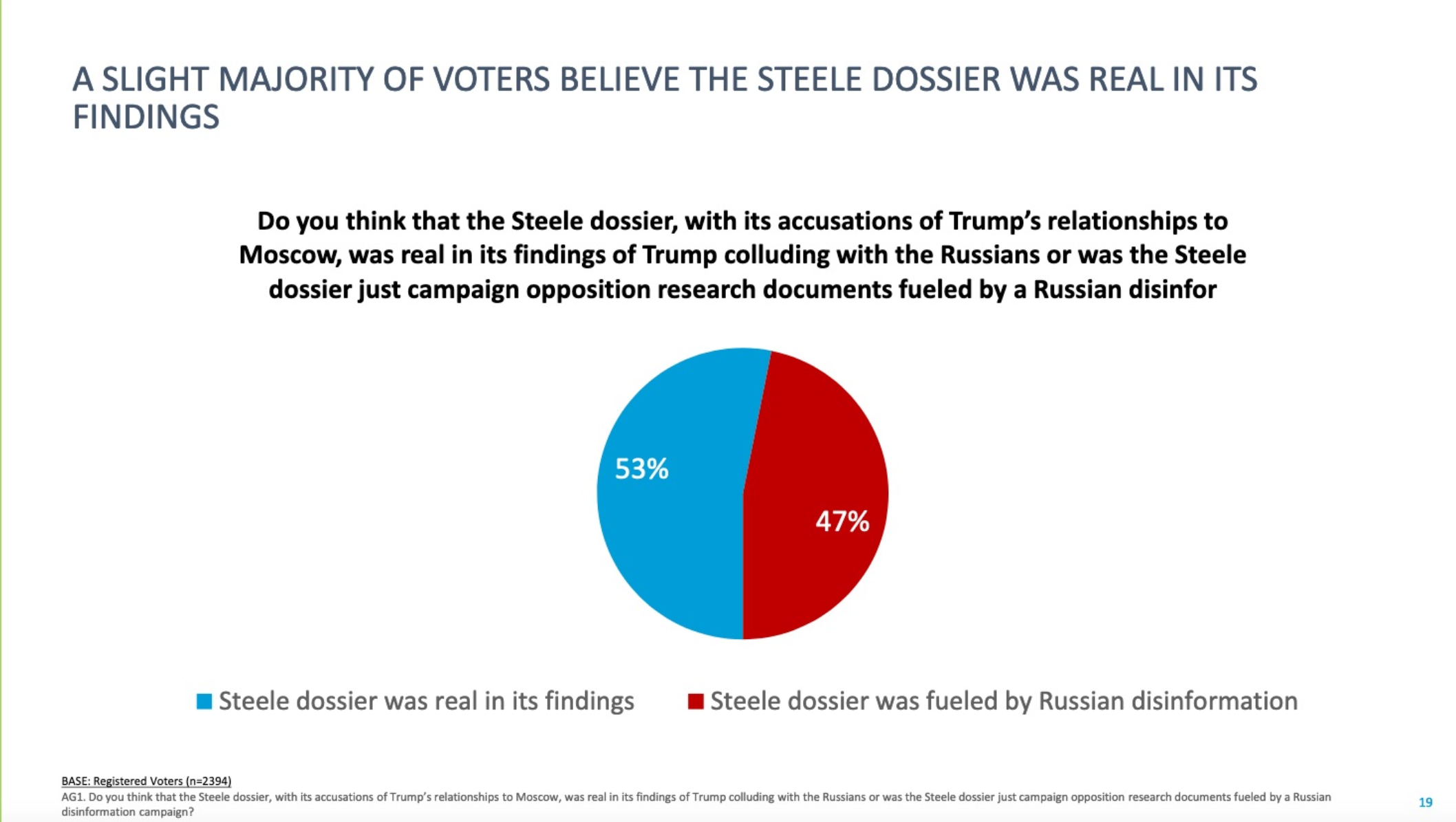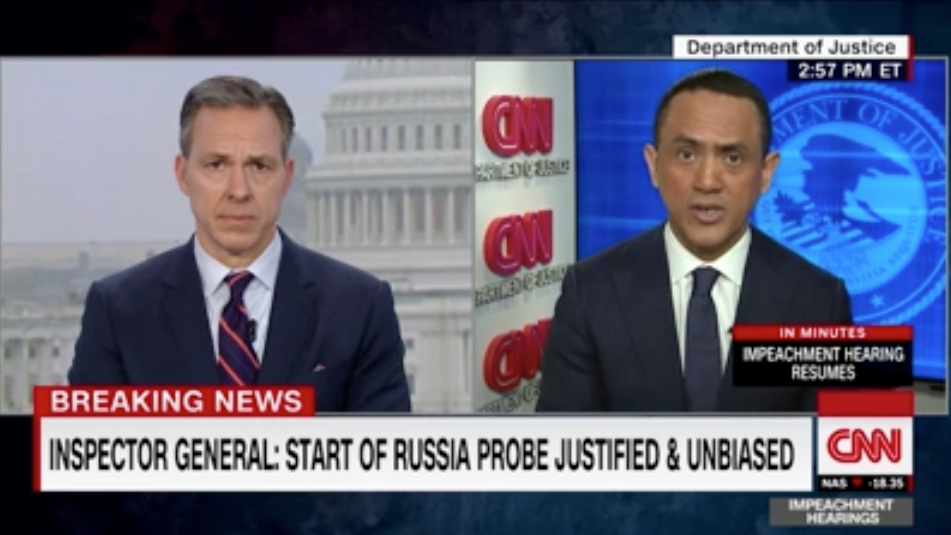Shock Poll: Majorities Still Believe Debunked Fake News About Trump And Russia
It's nothing short of a scandal that 53 percent of Americans believe that this completely discredited document 'was real in its findings of Trump colluding with the Russians.'
The media’s approval and credibility ratings may be low, but they still have a tremendous amount of political power. Whether they are attempting to destroy the life and reputation of Supreme Court Justice Brett Kavanaugh, working overtime to protect the reputation of Democratic presidential nominee Joe Biden, pushing the impeachment of a sitting president, attempting to control the outcomes of elections, or spending years peddling a false tale of treasonous collusion with Russia to steal the 2016 election, they get significant results despite failure to report accurately.
Evidence of that power and how irresponsibly it is used is found in a recent Harvard-Harris poll for April 2020. A majority of Americans, 53 percent, believe the Christopher Steele dossier “was real in its findings of Trump colluding with the Russians.” Only 47 percent of Americans chose the factually correct option that it was Clinton-funded campaign oppo fueled by disinformation.

The Steele dossier, and its central and elaborate theory that Trump was a secret agent of the Russian government who had betrayed his country to steal the 2016 election, has been completely discredited by multiple government investigations. The limitless special counsel probe, ostensibly led by Robert Mueller, could find no evidence that Trump had colluded with Russia. In fact, the Mueller team could find no evidence that any American had colluded with Russia to steal the 2016 election.
A more serious investigation by the Department of Justice’s inspector generalrevealed that the dossier was discredited by the federal government by January 2017. The leaky FBI forgot to leak that important fact, but the inspector general goes through the dossier’s many problems throughout its 478-page document.
One of the DOJ’s failures, for example, was that they “omitted the fact that Steele’s Primary Subsource, who the FBI found credible, had made statements in January 2017 raising significant questions about the reliability of allegations included in the FISA applications” based on the dossier. Of the dossier, the inspector general wrote, “We determined that prior to and during the pendency of the FISAs, the FBI was unable to corroborate any of the specific substantive allegations against Carter Page contained in the election reporting and relied on in the FISA applications.” By “reporting,” the IG is referring to the dossier.
Later, the IG writes that anything found to have been true in the dossier was already publicly available and reported elsewhere. “The FBI concluded, among other things, that although consistent with known efforts by Russia to interfere in the 2016 U.S. elections, much of the material in the Steele election reports, including allegations about Donald Trump and members of the Trump campaign relied upon in the Carter Page FISA applications, could not be corroborated; that certain allegations were inaccurate or inconsistent with information gathered by the Crossfire Hurricane team; and that the limited information that was corroborated related to time, location, and title information, much of which was publicly available.”
So it’s nothing short of a scandal that 53 percent of Americans believe that this completely discredited document “was real in its findings of Trump colluding with the Russians.”
But how could they think otherwise? While the false Steele dossier was legitimized and parroted daily for three years in every major media outlet, the IG findings of its falsehood were buried. The Washington Post has more than 24,000 articles on Trump and Russia. The paper even won awards for its participation in the conspiracy theory that Trump had colluded with Russia. When it all turned out to be definitively false, they simply moved on to the next story — Ukraine and impeachment. True, a laudable review of the false reporting appeared online to very little fanfare, but notably focused on other media outlets than the Post.
The New York Times was a central media outlet in promoting the false and dangerous conspiracy theory of treasonous collusion with Russia to steal the 2016 election. Nearly 18,000 articles about Trump and Russia appear on their web site. While Maggie Haberman and Ken Vogel publicly tweeted that the dossier’s authors and funders had willfully misled them about the partisan nature of the disinformation, they kept that information hidden or downplayed in subsequent stories.
When the Steele dossier became increasingly discredited, the Times’ reporters allowed the paper to be used to “put out an implausible new origin story for the FBI’s Trump-Russia probe.” When the dossier was exposed definitively in government reports as false, it was impossible for faithful readers of the Times to learn that information because it was never reported.
Nearly 18,000 articles based on the dossier’s central conspiracy theory, with awards for parroting its false information, and no admission of the journalistic failures once they were exposed. Times Executive Editor Dean Baquet felt no need to admit his errors on the story, previously saying of the false Russia coverage, “We built our newsroom to cover one story, and we did it truly well.”
Or take CNN, which went full conspiracy on the Trump-Russia story. In addition to round-the-clock peddling of the false and dangerous conspiracy theory for more than three years, CNN has some 11,473 stories on its website about Trump and Russia.
Three years ago this week, Jake Tapper delivered a closing sermon for his show about a poll he found “alarming.” Asked if the Obama administration “intentionally spied on Trump and members of his campaign during the 2016 election,” 32 percent of the public said yes. Tapper was alarmed not that the number of Americans knowing this fact wasn’t higher but that it was that high.
32 percent of the public thinks President Obama intentionally spied on Donald Trump and members of his campaign and 52 percent of Republicans believe this charge. A charge that there is literally no evidence to support. It is the definition of fake news.
CNN had reported just days earlier that the FBI began spying on Trump campaign advisor Carter Page in 2016. Here’s how their story began:
The FBI last year used a dossier of allegations of Russian ties to Donald Trump’s campaign as part of the justification to win approval to secretly monitor a Trump associate, according to US officials briefed on the investigation.
If your news organization reports, accurately, that the FBI had secured a FISA warrant to spy on a member of the Trump campaign, you shouldn’t get mad at people for believing what you report. But Tapper was apoplectic.
It didn’t take much intelligence to figure out that the dossier was complete bunk, but major media outlets were still relying on it and dubious selective leaks from intelligence operatives for their coverage. Tapper was one of the reporters who falsely suggested that Steele was a trustworthy official. A high-level leak to CNN about a briefing of the dossier to Trump and former President Barack Obama was one of the major stories that got the Russia conspiracy coverage really going. CNN won awards for their dutiful regurgitation and legitimization of that leak.
When the dossier was definitively discredited in the explosive IG report, Evan Perez (an undisclosed but extremely close personal friend of Fusion GPS operatives who peddled the dossier to compliant media) told Jake Tapper that the “topline” takeaway was that Trump was wrong to think he’d been wronged by the FBI. Note the chyron CNN used, which matches the desired talking point of compromised intelligence officials and dossier peddlers.

CNN’s original story on the dossier was “Intel chiefs presented Trump with claims of Russian efforts to compromise him,” but when the dossier was definitively discredited, it downplayed or ignored the finding, instead going with “How the FBI attempted to verify a salacious allegation in the Steele dossier.”
So if Tapper was upset that 32 percent of the public thought the Obama administration spied on the Trump campaign, and it did, how upset must he be that 53 percent believe what his network falsely peddled for years? A majority of Americans — and 81 percent of liberals, the group CNN caters to — believe that Trump colluded with Russia.
Tapper won’t deliver a sermon about Americans believing the fake news he and his outlet published, obviously. Everyone else should remember that, however much outlets and journalists may have discredited themselves through their garbage reporting, they still hold a tremendous amount of influence over, for example, 81 percent of liberals.





Post a Comment